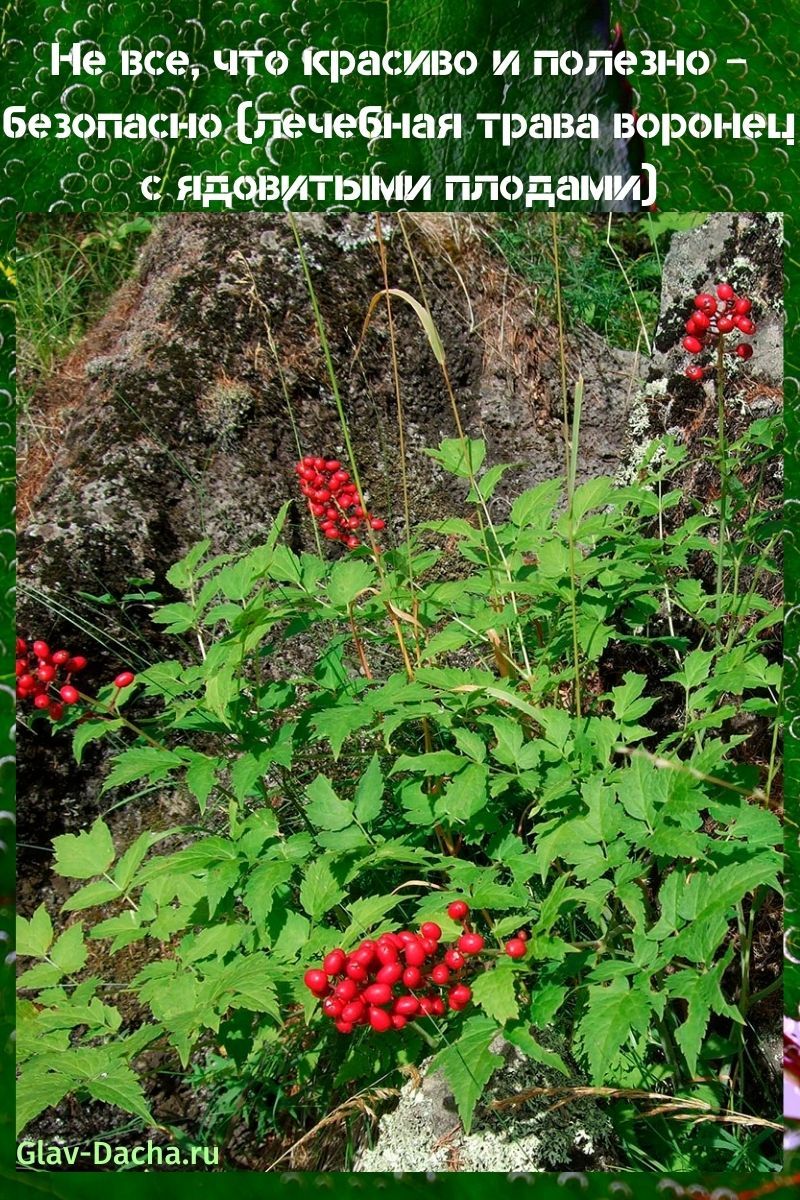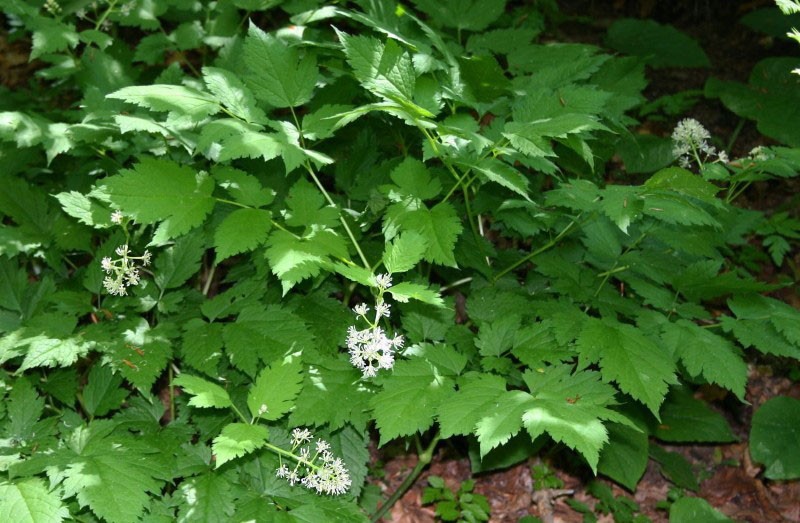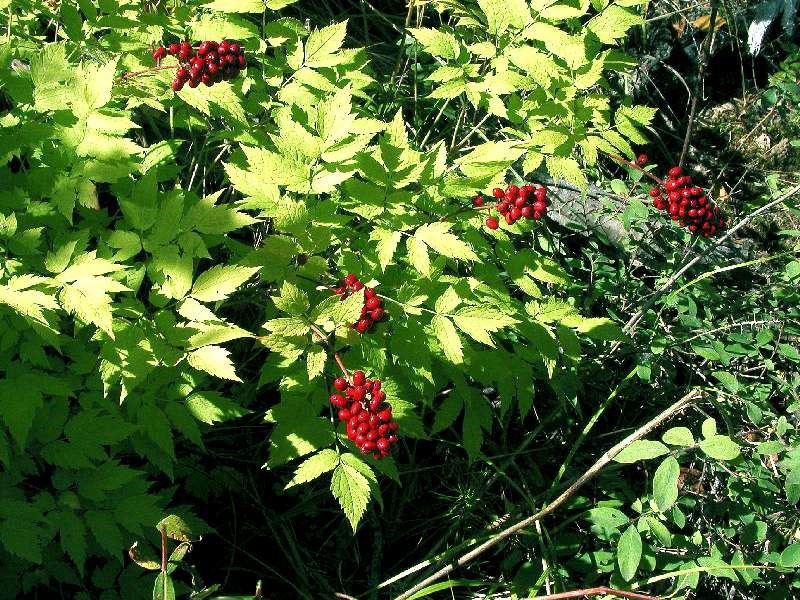Not everything that is beautiful and useful is safe (medicinal herb Voronets with poisonous fruits)
 The raven grass looks like a black chokeberry from afar, especially in autumn, when brushes with small berries ripen on the branches of herbaceous bushes. Black or red fruits not only add decorativeness to the plant, but are also healing. Most often, Vorontsov can be found in the wild in temperate climates. They are not rare and grow en masse in coniferous and mixed forests.
The raven grass looks like a black chokeberry from afar, especially in autumn, when brushes with small berries ripen on the branches of herbaceous bushes. Black or red fruits not only add decorativeness to the plant, but are also healing. Most often, Vorontsov can be found in the wild in temperate climates. They are not rare and grow en masse in coniferous and mixed forests.
Also, thanks to the beautiful feathery foliage and the original look of fruiting plants, they are often planted in private gardens. Someone does this in order to embellish the site, giving it the most natural natural look. And for someone, the harvest, medicinal berries, which are needed for the preparation of medicinal potions, are important. What is this unusual herb in the form of bushes and how is it valuable?
What is special about raven grass

In the genus Voronets, there are about three dozen perennial species. Each of them has its own individual differences, but they all have common features.
Raven grass is:
- herbaceous and quite compact shrubs no more than 90 cm high;
- stems are thin and straight, but strong enough;
- well developed rhizome;
- leaves are strongly dissected into lobes;
- inflorescences are long, from many small flowers on light oblong pedicels;
- fruits - leaflets, in the form of small spherical berries on long petioles, are tied in bunches and ripen in August.
In one place Vorontsov can grow up to 12 years. They are unpretentious and persistent, adapt well to adverse conditions. A well-developed root system helps the spreading bush to get moisture and nutrition from the deep layers of the soil.
The Voronet plant prefers forest thickets, feels good both in coniferous and mixed forests. It can also grow in swamps and rocky terrain. The herbaceous act can be found in our Siberian and Caucasian expanses, in the taiga.
Raven herb varieties
 Sprawling lush bushes are often used as decorative culture... The flowering itself is not of particular value - the flower of the funnels is small, nondescript in color. Foliage and berries give the shrubs decorativeness. The carved leaves are large, the cuttings contain three leaf blades with jagged edges. But the most striking accent is the berries, especially in the red-fruited species. Although black and white crows also look spectacular against the background of emerald foliage.
Sprawling lush bushes are often used as decorative culture... The flowering itself is not of particular value - the flower of the funnels is small, nondescript in color. Foliage and berries give the shrubs decorativeness. The carved leaves are large, the cuttings contain three leaf blades with jagged edges. But the most striking accent is the berries, especially in the red-fruited species. Although black and white crows also look spectacular against the background of emerald foliage.
From the Voronets clan, the following types of Voronets grass can most often be found:
- Spike-shaped (aka spiky). One of the largest-leaved species up to 60 cm high, serrated leaf plates. The inflorescence is oblong, the berries are black.

- Red-fruited. Shrub up to 70 cm high with light green triple-dissected leaves. It blooms with small white flowers, collected in a short oval raceme. Fruits in red berries.

- White. It got its name from large white berries with watery pulp.

- Pointed.It has beautiful foliage with sharp, toothed tips, and produces large and black fruits.

- Daursky (aka black cohosh). The tallest variety, grows up to 1.5 m in height. Frost-resistant, prefers nutritious humus loams. Small flowers smell nice, but the bush itself has a repulsive smell.

Voronets is a poisonous plant, regardless of its species. It is categorically impossible to eat berries of all types of grass, so as not to get poisoned.
Why is Voronet herb useful?
 A large proportion of the plantings were destroyed in connection with the collection of the plant for medicinal purposes. This is not surprising, because the raven is considered a medicinal culture. Both the aerial part and its roots contain a mass of useful substances, thanks to which the herb has a healing effect. The roots and fruits of the plant are considered especially useful, but there are also useful components in the shoots and leaves themselves. To date, the chemical composition of the herb has not been fully studied and it is used only in traditional medicine. However, it is known that the raven is rich in alkaloids, fatty oils, saponins and narcotic substances, and the leaves are rich in vitamin C.
A large proportion of the plantings were destroyed in connection with the collection of the plant for medicinal purposes. This is not surprising, because the raven is considered a medicinal culture. Both the aerial part and its roots contain a mass of useful substances, thanks to which the herb has a healing effect. The roots and fruits of the plant are considered especially useful, but there are also useful components in the shoots and leaves themselves. To date, the chemical composition of the herb has not been fully studied and it is used only in traditional medicine. However, it is known that the raven is rich in alkaloids, fatty oils, saponins and narcotic substances, and the leaves are rich in vitamin C.
The deciduous part of the Voronets is harvested in late spring or early summer. It is cut and dried in the fresh air, spread out in one layer in the shade. The roots are dug up either in spring or in autumn and dried in a quick way at a temperature of no more than 40 ° C.
For medicinal purposes, the red-flowered raven is mainly used - it is the most effective, with a rich composition. However, other types of herbs (white, spike-shaped, pointed) are also medicinal.
In addition, grass can provide benefits not only to health, but also to the farm. Previously, its berries and leaves were used as a natural dye for dyeing wool and making ink. Black dye was obtained from berries, and red from young foliage.
Medicinal properties of the herb

The raven plant is primarily very useful and effective for diseases of the nervous system. Also herbal products:
- relieve inflammation, headache and stomach cramps;
- soothe;
- have a laxative and emetic effect;
- contribute to the destruction of tumor formations, including malignant ones;
- stop uterine bleeding;
- restore the menstrual cycle;
- normalize the work of the cardiovascular system;
- treat skin and respiratory diseases.
Do not forget that the raven is a poisonous plant, and even during drying it does not lose its dangerous properties. It is important to observe the dosage and not abuse the decoctions.
It is strictly forbidden to eat berries, neither fresh nor dried - they are the most poisonous. In addition, the leafy part is irritating to the skin.
What diseases are ravens used for

Infusions and decoctions are prepared from the herb, which are used for treatment:
- rheumatism;
- asthma;
- oncological diseases;
- gastritis;
- ulcers;
- enterocolitis;
- malaria;
- tuberculosis;
- disorders of the thyroid gland;
- gynecological problems;
- diseases of the heart and blood vessels;
- skin diseases.
How to cook and use raven
 The flower or grass of the funnels is first dried, and then decoctions, infusions, tinctures and even ointments are made from it. During preparation and ingestion, especially orally, it is important to carefully observe the dosage so as not to get poisoned.
The flower or grass of the funnels is first dried, and then decoctions, infusions, tinctures and even ointments are made from it. During preparation and ingestion, especially orally, it is important to carefully observe the dosage so as not to get poisoned.
It is strictly forbidden to use the herb for the treatment of nursing, pregnant and young children.
Water infusion
 An infusion is prepared from the dried deciduous part, pouring 10 g of grass with a glass of boiling water. They insist on the remedy for an hour, and then filter and drink three times a day for 1 tbsp. l. The herbal infusion is effective for uterine bleeding, malaria, tuberculosis.
An infusion is prepared from the dried deciduous part, pouring 10 g of grass with a glass of boiling water. They insist on the remedy for an hour, and then filter and drink three times a day for 1 tbsp. l. The herbal infusion is effective for uterine bleeding, malaria, tuberculosis.
Decoction of rhizomes
 Dried grass roots in an amount of 20 g are crushed, poured into 1 liter of water and boiled. The amount of liquid should be reduced by 1/3. Then the broth is left overnight to infuse. The strained ready-made broth is taken in 1 tbsp. l.3 times a day for rheumatism and headaches.
Dried grass roots in an amount of 20 g are crushed, poured into 1 liter of water and boiled. The amount of liquid should be reduced by 1/3. Then the broth is left overnight to infuse. The strained ready-made broth is taken in 1 tbsp. l.3 times a day for rheumatism and headaches.
Alcohol tincture
 For diseases of the nervous system, alcoholic tincture is especially useful: 1 tbsp. l. dry roots or berries are poured with 300 ml of alcohol (70%). The preparation is insisted for 7 days in a dark place, shaking occasionally. Take such a tincture, measuring it in drops, no more than 30 at a time, and no more than 4 times per day.
For diseases of the nervous system, alcoholic tincture is especially useful: 1 tbsp. l. dry roots or berries are poured with 300 ml of alcohol (70%). The preparation is insisted for 7 days in a dark place, shaking occasionally. Take such a tincture, measuring it in drops, no more than 30 at a time, and no more than 4 times per day.
Ointment
 For the treatment of skin diseases and damage to the skin, a fat-based Vorontsov ointment is prepared. To do this, finely grind 20 g of dried fruits of Voronets and mix them with 100 g of warmed up fat. Petroleum jelly can be used instead of fat. The ointment must be allowed to stand for at least a week before it can be applied.
For the treatment of skin diseases and damage to the skin, a fat-based Vorontsov ointment is prepared. To do this, finely grind 20 g of dried fruits of Voronets and mix them with 100 g of warmed up fat. Petroleum jelly can be used instead of fat. The ointment must be allowed to stand for at least a week before it can be applied.
As you can see, the main purpose of the black grass is still use as a medicine. Of course, only after consulting a doctor. And in compliance with the recommended dosage, because the plant is poisonous. At the same time, if desired, cute Voronets bushes with carved foliage and bright berries can be planted in the garden. The main thing is to make sure that children cannot feast on its fruits.